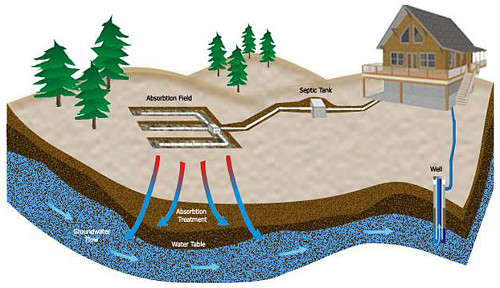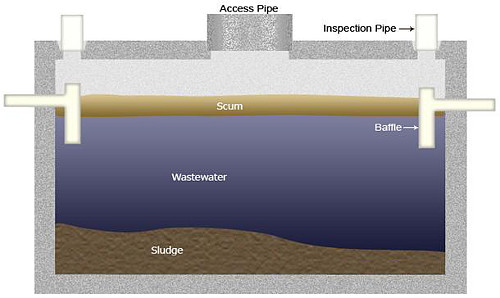Planning - On-site Wastewater Treatment Systems
- Do's and Don'ts
- Operating Permit Information
- Other Resources
- Sale, Transfer or Change in Designation of Property
- Service Providers
- Visit FORMS to view forms related to On-Site Wastewater Treatment Systems.
How does an On-site Wastewater Treatment System (OWTS) work?
An on-site wastewater treatment system consists of four major components: the building sewer (pipe exiting home), the septic tank, the drainfield (or absorption system) and the soil. The septic tank separates the solids from the liquids before the liquid (or effluent) enters the drainfield. The absorption system then disperses the effluent into the soils. Microorganisms in the soil provide further treatment by removing constituents such as nitrates, phosphates, bacteria and viruses.

What can a property owner do to maintain an OWTS?
At a minimum, taking these four steps to maintain an on-site wastewater treatment system may prolong the life of the system:
- Conserve water.
- Flush responsibly.
- Pump the septic tank.
- Take care in what goes down the drain.
Why is it important to pump the septic tank?
The solids from household wastes accumulate in the septic tank and are more commonly called "sludge". With continued use, this sludge volume continues to increase over time. If the sludge volume reaches the outlet tee, it begins to enter the drainfield. The sludge will eventually plug the outlet pipe of the septic tank and/or plug the drainfield soils, therefore, decreasing the soils’ infiltration ability. A soil’s infiltration ability is its ability to filter the effluent’s contaminants, such as nutrients and pathogens. Once the drainfield is plugged with solids, it loses its effectiveness in treating wastes, which include nutrients and pathogens. These untreated nutrients and pathogens can potentially contaminate nearby surface and groundwater sources.
How to Conserve Water
- Take short showers instead of baths.
- Leave faucets off while brushing your teeth or shaving.
- Wash dishes and clothes only when you have a full load.
- Fix leaking faucets and toilets.
- Replace older dishwashers, toilets, washers and shower heads with high-efficiency models.
Take care in what you put into your drains.
The following lists include items that should not be put into your OWTS:
Do Not Flush:
- Cat litter
- Cigarette butts
- Condoms
- Cotton swabs
- Dental floss
- Diapers
- Feminine hygiene products
- Paper towels
Do Not Flush or Pour Down Drains
- Antifreeze
- Non-household chemicals
- Cooking oil
- Gasoline
- Grease
- Motor oil
- Paint or paint thinners
- Pesticides
Household cleaners should be used in moderation so that they do not interfere with the biological processes that take place in an on-site wastewater treatment system.
Restrict the use of a garbage disposal or do not have one at all.


